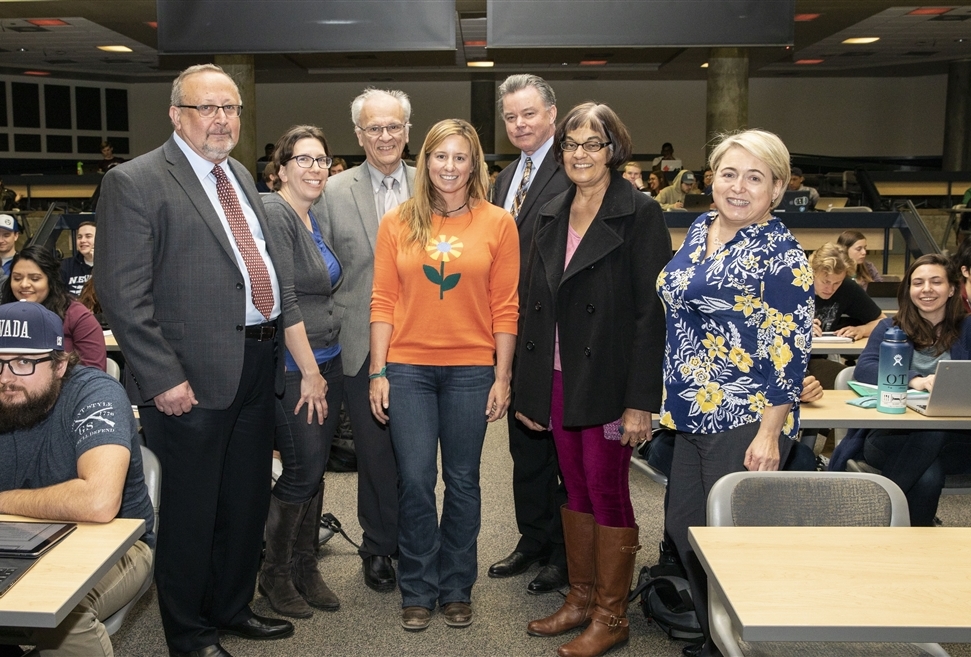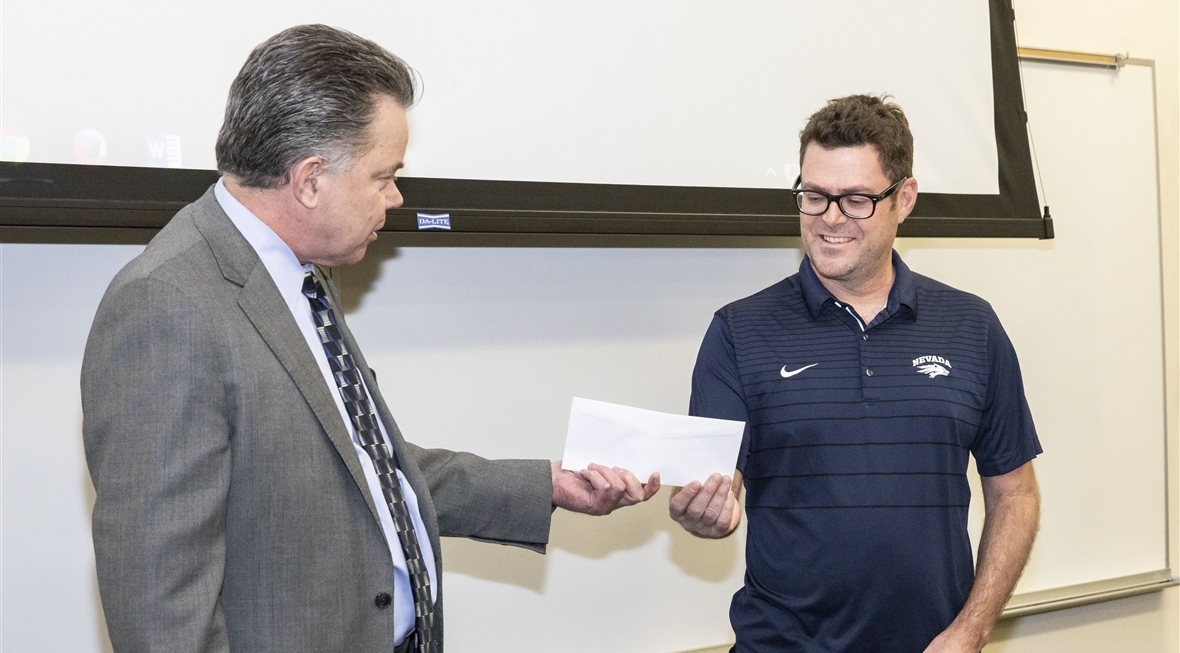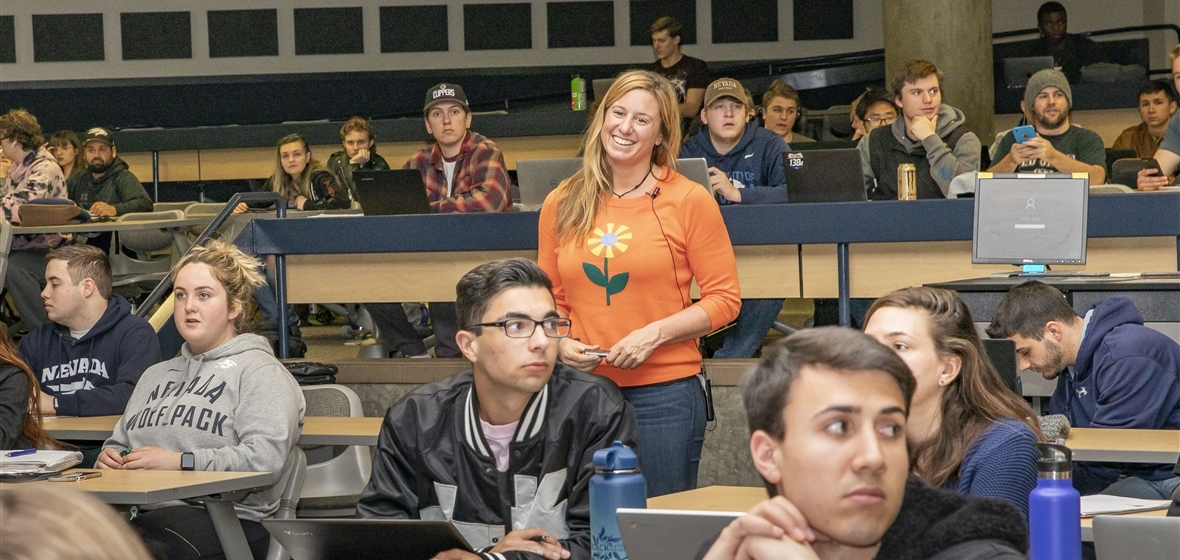In April, when the winners of the F. Donald Tibbitts Distinguished Teacher Award were notified of their good fortune in surprise ceremonies during the middle of classes they were teaching, it became apparent that there might be more similarities than differences between the winners.
Certainly, Ann-Marie Vollstedt and Geoffrey Smith teach entirely different academic disciplines.
Vollstedt is a lecturer in the College of Engineering. Smith is an associate professor in the Department of Anthropology in the College of Liberal Arts.
That's where the differences end. There are far more similarities.
Take how their time is spent during the summer months. There is little down time for either.
In addition to her lecture duties during the school year, Vollstedt is one of the prime forces behind the success of the College of Engineering's "E-FIT," program, which is part of the University's larger "NevadaFIT" academic boot camp effort. In August, as the members of "E-FIT" first come to campus, it is Vollstedt (who is quick to point out that it isn't just her, it is several other faculty and staff members as well) who helps calm parental fears and provides the positive reinforcement that the college's yearlings have it within themselves to succeed in an academically rigorous environment. The preparation and planning for "E-FIT" takes up more than just the summer. In a recent visit to Vollstedt's office on the first floor of Scrugham Engineering, there were already boxes of materials of E-FIT scattered throughout her work space.
"We started from scratch," Vollstedt said, recalling how in after an initial meeting with Provost Kevin Carman to discuss an outline of how what was then called "ScienceFIT" would initially work, in five short years the program would grow from 30 to 50 to 100 and now well in excess of 600 students. "There are a lot of long days ... days that run from 8 a.m. to 9 p.m. (during the week-long session of programming, activities and mentorship in August). It's a challenge to keep things fresh and meaningful for all these new students. And it's just as important to help them all feel welcome. There's so much energy on campus at that time of year, when things are just getting started. One of the biggest goals is for the students to experience that energy, that excitement, which comes with when you're new to a college campus."
For Smith, there is a similar energy surrounding learning that he often finds in rural Nevada and Oregon during the summer. It's a time when he looks forward to the same kind of long days that Vollstedt experiences, with only a slightly different twist. It's outdoors instead of indoors, but the hours are similar - sunset to sundown. The goal is very similar, too, when Smith is with a handful of graduate and undergraduate students studying Paleoindian archeological sites.
"Being a professor is part being a salesman and part understanding and explaining your material," he said. "You have to find ways to make it engaging as well as educational. Learning can be like an adventure. When you're out in the field with your students, the hope is that you can make the experience meaningful enough that it will be exciting and memorable for them."
Two great teachers.
Two award winners.
Two different stories.
Here is a look at this year's Tibbitts Award winners.
Ann-Marie Vollstedt

Vollstedt came to campus as an intercollegiate athlete. She was a diver on the Wolf Pack women's swimming and diving team and was also a Western University Exchange (WUE) student, coming from her home in Alaska when she arrived on campus in 1997.
"The diving team had a really good coach (Jian Li You, who today is in her 22nd season at the University). The campus is in close proximity to Lake Tahoe. The weather is nice. The engineering program here at the University is really good," Vollstedt said. "It all came together in a kind of weird combination of factors for me."
From her parents, both of whom have master's degrees, Vollstedt learned the value of not necessarily pursuing the highest-paying profession. Rather, she said, "Finding something you love to do. That was an important lesson I learned. If you find something you don't like, you're going to be miserable. Life is too short to be miserable."
Vollstedt always enjoyed mathematics and science. After receiving her undergraduate degree in Engineering in 2002, she began working toward her master's degree at the University. It was while she served as a T.A. for Eric Wang, an associate professor in mechanical engineering, that she realized being in front of a class was something she enjoyed.
"I remember I thought, ‘Wow, this is something I should be doing,'" she said. "I really liked teaching, and interacting with the students."
She soon became fascinated with the whole craft of teaching. While she was working on her master's degree, she became involved with a robotics program with the Washoe County School District. That led her to get a second master's degree, in education, in 2005.
Her timing and qualifications could not have come at a better time for the college. As she was working on her Ph.D. in Engineering, Manos Maragakis had become dean of the college. Among Maragakis' many goals as a new dean was to build on the college's legacy of great teaching. He felt that new, hands-on, experiential approaches would be critical to the school's teaching success.
Instructors with exceptional teaching gifts - the ability to master complex material in transformative ways that would engage student learning habits that were, themselves, transforming in the digital age - became sought after by the college. Vollstedt completed her Ph.D. in 2009, and soon joined the College of Engineering faculty. She was well aware that in addition to the college's well-deserved reputation for high-end research, it was also a place that placed a premium on being a great teacher.
"There are so many great teachers in this college," she said. "I've known about many of them. I've always aspired to be like them."
When she joined the faculty, she was becoming part of a faculty that included the likes of past Tibbitts Awards winners Candice Bauer (2014), Sergiu Dascalu (2011) and her advisor, Wang (2003) - instructors and professors in the college who were highly regarded across the University campus for the innovative ways they presented their material.
One of Vollstedt's first duties was to become one of the first points of contact for all engineering students by teaching the college's introductory course, Engineering 100.
"I think Dean Maragakis has a vision for all students in the college to not only learn the things they will need to be successful, but also to know they're enjoying what they're learning in class," Vollstedt said. "He had a vision that from the very beginning, that this would start when they were freshmen."
Said Maragakis: "Ann-Marie has an exceptional ability to make people enjoy the work they're doing. I've never known her to complain about anything. Ann-Marie is a problem-solver. She comes at everything that way. It isn't about obstacles; it's about finding ways around those obstacles. It's always about solving problems."
Vollstedt keeps things fresh and lively in her classes through a variety of methods. When the complexity of the material feels a little daunting, it's not uncommon for her and 400 students to engage in a heated competition to see who can come up with the best paper airplane designs - and then transfer that fundamental knowledge to help solve larger problems.
"I want all of my students to be super-excited about what they're learning," Vollstedt said. "And I want them all to know that I'm here for them, and that I'm super-excited about their futures."
Spend any amount of time with Vollstedt, and it quickly becomes apparent that she is an extremely positive person. She said she is so positive because of the environment where she works. She quickly noted that she has been "blessed" to have great mentors - from Wang to longtime civil engineering professor David Sanders to Indira Chatterjee, an associate dean in the college who throughout a storied 31-year career at the University has inspired students and helped blaze new paths for female faculty.
"I've been very lucky to learn from some really great people," she said. "I've had so many great mentors. The college has had a vision for great education.
"Whenever I have questions, or whenever I want to talk about teaching, I can always go into the offices of these great people, and share ideas with them. Throughout my time here, I've learned from people who have valued education. They've helped pave the way for me."
It helps, of course, to have an energy level for her life that could be charitably described as quite high.
"That's what I love to do," Vollstedt said of the times she's been asked to help with an effort like E-FIT. What Maragakis termed problem-solving, Vollstedt put another way: "I love being given something and then running with it."
Geoffrey Smith
.jpg)
Geoff Smith will be the first to admit he wasn't the best student in the world. Like many young people, it wasn't that he lacked intellect or interest about the world around him. It was just finding that one thing that would spark an interest while he was in college that was difficult.
Born in Canada, he was attending the University of Prince Edward Island. He thought he might be an engineer.
But, "I was a terrible undergrad student," Smith said of his first semester of college. "No, scratch that. I was an awful undergraduate student. Anthropology was my one my bright spot."
Smith credited his father, Don, an artist and historian, with helping to turn the academic tide in favor of Anthropology. It was during this time that Don took Smith on an archaeological dig. The experience changed everything for Smith: "After almost flunking out of school, my father took me on an archaeological dig. It was a life-changing event and set me on my current course."
In Anthropology and Archaeology, Smith would find a home. Perhaps it had been there all along -- his mother, Mary, was a scientist; his father, Don, as an artist and historian, knew the value of narrative. Anthropology was a discipline that mixed science with artistry and history, with storytelling. To understand the significance of, say, a Native artifact, a practitioner would have to dig deeper - literally and figuratively - to understand its meaning and where best to lay it across the context of time.
"I feel so lucky to be able to do archaeology," said Smith, whose area of expertise includes the Great Basin's pre-history and paleoecology, particularly in the Pleistocene/early Holocene era of 14,500 to 9,500 years ago. His analysis of obsidian artifacts in the Black Rock Desert/High Rock Country of northwest Nevada and south-central Oregon has helped us come to a better understanding of the movements of the first people in the New World. "The work contributes to our understanding of human history ... which is a global process, but I'm looking at it on a local scale."
He added, "We don't know all the answers about the first Nevadans and Oregonians, and we're still working on finding them. That's part of the allure of what I do - discovering new things that can contribute to the understanding of who these first people were."
Whenever he is out in the field with his students, Smith is well aware he is in a special kind of classroom.
"There's no cell service and maybe you won't see people for seven, eight days," he said. "That's rare. And it gives us a rare opportunity, my students and I, to learn new things together. It's not just the work in the field. It can be from how do you cook for 10 people at night ... to how do you change a flat tire on the side of a gravel road in rural Nevada."
As much as he loves the outdoors, and loves the opportunities the "outdoor" laboratory of the Great Basin's open spaces provide him, Smith is just as effective within the confines of a classroom. He joined the University faculty in 2010. In a few days he will graduate his 21st graduate student when University celebrates its spring commencement exercises.
"It's a huge reward when get to see your students grow, and contribute through their work to our understanding of the world," he said.
"Over time his students repeat the same things about what kind of teacher he is," College of Liberal Arts Dean Debra Moddelmog said during the impromptu interruption of Smith's class when Provost Kevin Carman announced to the surprised teachers - and equally surprised professor - that Smith had won the Tibbitts. "‘He's awesome ... he's engaged ... he cares," Moddelmog continued. "And he's always working to improve. He's never satisfied. He's always reaching for that top level."
Smith admitted he asks a lot of himself, particularly when he lectures.
"I always feel I run the risk of making something that is full of adventure and that is inherently exciting something that might seem dreadfully boring," he said, smiling. "That's why the stories ... the storytelling aspect of what I do ... is so important. You want to share compelling stories with your students - stories that help make the people, and the archaeology, come to life."
For the most part, Smith said, how can he go wrong?

"I teach a subject that is full of adventure, and it's full of very interesting and colorful characters," he said. "Interesting characters are a big part of any story."
Smith said he often looks at his lectures with a very clear beginning, middle and ending.
"And it's the points in between that tell the 14,000-year story of archaeology in Nevada," he said. His lecture style is informal, yet focused. "I don't use notes," he said. "It's mostly from memory. I'd like to think that at this point in my teaching career most of the rough edges have been smoothed over and I can tell a good story to the class."
Smith is also at a point in his career where he readily acknowledges that the environment in which he works - the Department of Anthropology, which is rapidly growing and features several dynamic, talented, early to mid-career professors like Smith - helps spur him to ask more of himself.
"Our department has had an amazing run," Smith said. "We've hired seven new faculty since I started, and all of them have been extremely productive. There is lots of energy in the department, and I think collectively, we've all have helped raise the bar for success."
As accomplished as he is in the classroom, Smith admitted that just like any other professor on campus, the reward often isn't always in a well-delivered lecture that resonates with character and context and meaning. Sometimes, the greatest reward comes in the quieter moments when something discussed months ago turns into a new thought, or a new paper, or a new piece of scholarship that adds to overall knowledge.
"I'm working on a paper right now with a colleague and a student," Smith said recently in his sixth-floor office in the Ansari Business Building. Like Ann-Marie Vollstedt, as he described what he was doing, it felt like it was yet another example of an accomplished professor finding an idea and then "running with it" in his/her unique way. "We discussed and debated it all summer long around the campfire when we were out in the field. And before you came by to visit today, I was working on it in the lab with my student. We've been talking about it for the past year. It just goes to show you that even when you're working in a remote setting, living in rural Nevada or Oregon for a summer, that it's teaching and research that we're doing. It all just depends on how you look at it."












